It’s been two years since we got our first look at Zelda U, and now there’s less than two days until the hood is finally pulled off the secretive title.
We sadly will not see the game released in time for its 30th anniversary, with it being delayed to next year (likely to NX launch in March), but that does little to dampen the anticipation Zelda fans have for the title’s re-unveiling. Well, by fans I mean actual fans, not the ones that think Zelda should be more like Dark Souls, that Wind Waker’s art style is too kiddy, that the series requires voice-acting to be playable, or the numerous others with similarly unpleasant opinions.
So if you’re up for some speculation, let’s dive right in.
While we have been patiently waiting for Nintendo to reveal more information on the new title, they have released three remakes: Wind Waker HD, Majora’s Mask 3D, and Twilight Princess HD.
The reasons for releasing so many remakes during this period (outside the obvious financial benefits) appears to be two-fold. First, to whet the appetite of your average rabid Zelda fan in an industry now reliant on 3-5 year development cycles, and second, to experiment with gameplay ideas to transplant into future games. There may be even a third story/timeline reason for the release of the latter two games, but I will get into that a bit later on.
What’s nice about these remade titles is that they were not just slapped on a disc/cartridge and shipped out the door like so many publishers are prone to doing with remasters this generation. Outside the typical improvement of visuals through texture redrawing and resolution adjustment, all three titles included a number of gameplay additions to either make certain aspects more enjoyable, more user-friendly, or less tedious over-all.
Wind Waker HD, for example, included the Swift Sail, which allowed players to traverse the ocean faster than before, also eliminating the need to play the Wind’s Requiem to change the wind’s direction. The infamous Triforce quest was also stream-lined, eliminating a huge source of tedium in the original title. Other changes included addition of touchscreen/gyro controls, being able to take up to 12 pictographs instead of the original 3 (to reduce backtracking to finish off your figure gallery), and the ever-appreciated Hero Mode being available from the start for experienced Zelda fans to enjoy right off the bat, a feature that has now become standard in Zelda titles.
Majora’s Mask 3D included a revamped save system, a more convenient and functional Bomber’s Notebook, and even completely reworked almost all of its bosses.
Twilight Princess HD simplified the tedious Tears of Light collection, added the Ghost Lantern to ease the pain of finding 60 Poes scattered across Hyrule, and allowed the player to switch between Link and Wolf Link with a simple touch of the GamePad.
Of course there are many more changes of both significant and superficial variety in all three titles, but if I listed them all I would be here all day. The point I was making with this is that in these titles Nintendo placed a huge focus on functionality and practicality for the user, and I believe these changes are an example of what we can expect from Zelda series moving forward.
 So this may hint at what we can expect from Zelda U, but we know that’s not even close to the full picture. Let’s take a link to the past and analyze some quotes from Eiji Aonuma as we try to piece together just what kind of game Zelda U will be.
So this may hint at what we can expect from Zelda U, but we know that’s not even close to the full picture. Let’s take a link to the past and analyze some quotes from Eiji Aonuma as we try to piece together just what kind of game Zelda U will be.
“Previously I thought that users wanted to be led, shown the way forward and not get lost or stuck. I thought that if they got lost or stuck then they wouldn’t enjoy the game, but reading feedback on the internet and Miiverse I’ve realized now that users really enjoy getting stuck sometimes and that they want to have a sense of getting lost and discovering the correct path themselves. This is really what Zelda is about.”
This quote, I feel, is the most significant from all of Aonuma’s interviews, because as he puts it, “This is really what Zelda is about.” Let us think back to the original Legend of Zelda for the NES, a title that drops you in the middle of a world crawling with monsters with only the slightest hints of where to go. No floating markers pointing in the right direction, no breadcrumb trails, and no hand-holding. It is clear that it is this feeling that the Zelda team wishes to recreate with Zelda U, at least from an exploration perspective.
“We actually had some feedback from Skyward Sword, where people were saying, ‘This is not exactly the Zelda game I was looking for, I was looking for a bigger open world.’ Unfortunately, I can’t go into details but I’m hoping to put a surprise, or kind of a twist, on my view of an open world game. I hope that you’ll look forward to it.”
Aonuma’s open world comments have perhaps been his most controversial, if only because it feels like every publisher has their own “open world” game this generation; a genre that has long been associated with vast areas of empty space with nothing to do and filler, cookie-cutter game design.
Unfortunately, console Zelda games have already gotten more than their fair share of complaints for their empty hub fields, in particular the open oceans of Wind Waker and the empty skies of Skyward Sword. I can only imagine it is quite difficult to find that healthy balance between creating a large, sprawling world for players to explore while also keeping it exciting and compelling. The reality of any open-world game is that there just isn’t enough resources to have both a dense and sprawling overworld. Unless, of course, you wouldn’t mind playing the game sometime in 2030.
In regards to what Aonuma’s “twist” to the open world formula is, I believe his comments on how the player approaches a particular location is the key. If we consider the world map to be a giant puzzle in and of itself, then we may be able to utilize different methods to get to a certain spot.
For example, say that there is a small island in the middle of a lake. Perhaps it would be possible to get to the island using different items, say floating down from a nearby mountain using the sail cloth, or freezing the water using an ice spell or rod, or perhaps you can bomb a nearby tree so you can walk across to it. This would really ramp up the puzzle-solving, and certainly be move involving than most open world games are in regards to environment traversal.
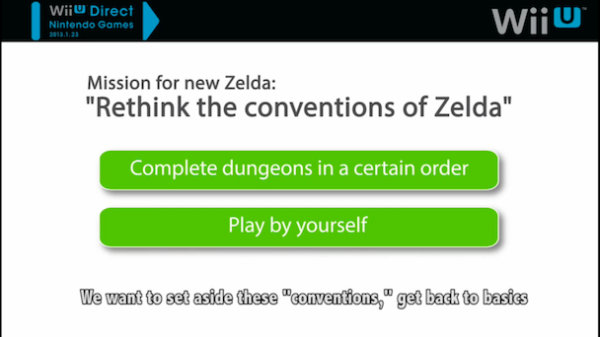 Zelda games, while having different styles and gameplay mechanics to set them apart, have had nearly-identical progression mechanics since A Link to the Past:
Zelda games, while having different styles and gameplay mechanics to set them apart, have had nearly-identical progression mechanics since A Link to the Past:
- Go to Dungeon 1
- Obtain new item
- Use new item to solve puzzles and defeat boss
- Proceed to Dungeon 2
- Rinse, repeat.
The first time this formula was switched up was with A Link Between Worlds, in which you could do dungeons out of order, giving the player the choice to decide where to go first. However, in keeping with the formula of using a particular item to solve puzzles and defeat the boss, you could not traverse a particular dungeon without first renting its required item from Ravio’s shop, unfortunately resulting in a somewhat superficial feeling of increased freedom.
This appears to have left the Zelda team in a bit of a quandary. How could they keep the puzzle-solving that Zelda games are known for while at the same time giving the player even greater freedom in how they approach their playthrough? Aonuma addressed, or rather, teased the possibilities in another interview
“The impact of the player character on the environment that has been, and really, having the player experience the impact, is something that is consistent through all versions of the Zelda games, but I want to continue to have players experience that and even build upon that experience. In traditional Zelda games there is kind of an order in which you do things. You can’t do 3 until you do 1 and 2 for example. But with the new Zelda game, I really want to open the opportunities up for the players to really make an impact on their environment and to give them a little more freedom to choose their path the story takes.”
Considering this interview was conducted after the release of A Link Between Worlds, Aonuma is definitely implying something more involving than merely doing dungeons out of order. This raises the exciting possibility of having more freedom to do anything we want than we have ever gotten out of the series up to this point, perhaps even to the point of doing story or sidequest events out of order with varying consequences.
This brings us back to the subject of items. Considering how important items have been to the puzzles of the series, how could they be implemented in a form that also allows increased freedom for the player?
I believe the best way to meet both requirements would be to allow the player to approach puzzles from multiple angles. This does not necessarily need to even complicate a puzzle, as one can see from my island example above. Perhaps certain items could make progressing through certain areas or fighting certain enemies or bosses easier, much akin to progression classically seen in the Mega Man series.
The other bullet point on the above slide is the Zelda convention of “Playing by yourself.” It’s possible that this could purely relate to Miiverse implementation, such as the bottles from Wind Waker HD, but it’s more interesting to think of the possibilities of multiplayer in Zelda, particularly after playing the likes of Four Swords and Triforce Heroes. Of course, I don’t believe for a second that we will be seeing that sort of multiplayer implementation in Zelda U. Instead, I think a more passive implementation, more akin to the Tingle Tuner from Wind Waker, or the trading and squad missions from Xenoblade Chronicles X, is a far more realistic expectation.
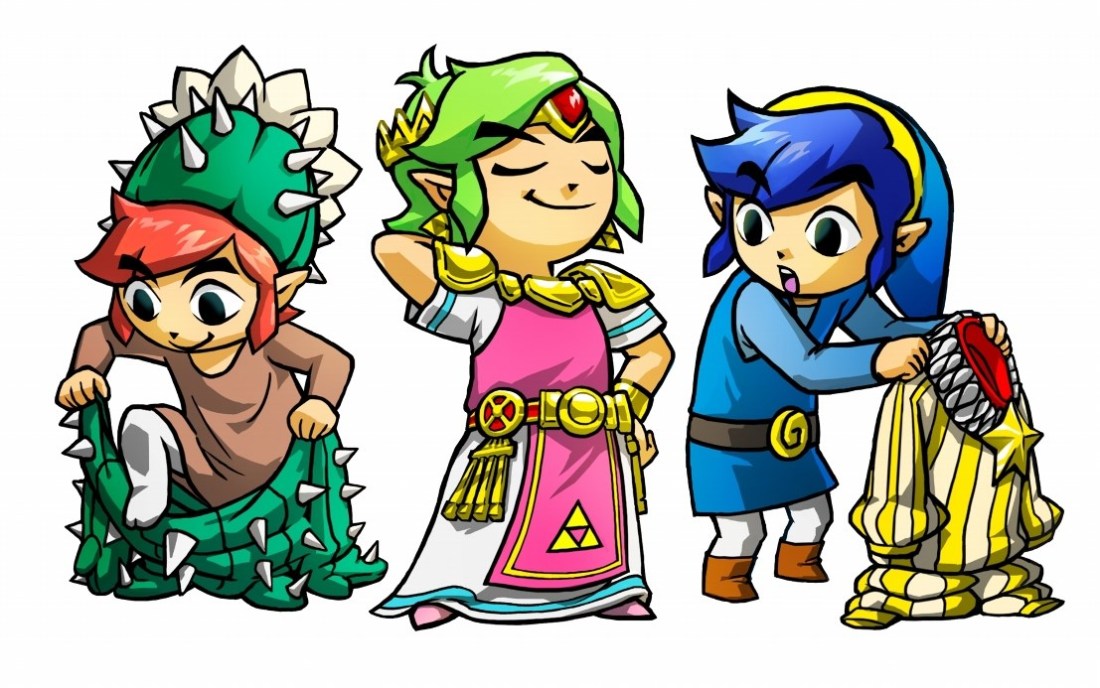 Sorry, no showing off that spiffy Princess dress to your friends…
Sorry, no showing off that spiffy Princess dress to your friends…
“We also have to reflect on what we did with Wind Waker for our next title. Since Wind Waker HD was a remake, there were limits to what we could do with the Wii U GamePad, but for a new title, we can utilize it to the fullest”
While we know now that Zelda U will also be coming out for the NX, I am going to assume the NX will utilize a touchscreen controller of some sort, else it’d limit the GamePad utilization within the game. I will save any possible NX version speculation for a time when we actually know what the NX is and what it is capable of.
Going off the Wii U/3DS remakes, we will most definitely see a majority of their new features transferred over to Zelda U, including off-TV play, use of the GamePad for the map and item-switching, and gyro aiming. In addition to this, I believe we will see a return of the note-sketching feature that was first featured in Phantom Hourglass, especially with the larger map to explore.
In regards to how the Zelda team can expand upon this, a key piece to this puzzle most certainly lies in the mysterious Sheikah symbol-laden tome that is tied to Link’s belt, as first seen in the teaser shown at the end of last year and in the artwork seen below.
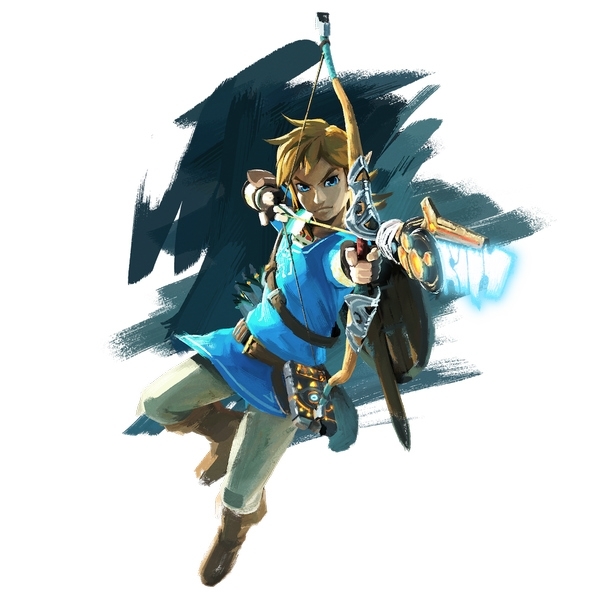 The Sheikah symbol has always been associated with items that allow Link to see the “truth” in different ways. The Mask of Truth allows Link to see into the mind of Gossip Stones and animals. The Lens of Truth allows Link to see invisible objects or see through false walls. The Hero’s Charm allows Link to see enemies’ health bars. Going by this trend, it seems more likely than not than this tome will allow Link to see the truth of something, whether it be used in a manner similar to past Sheikah items, or in a new manner altogether.
The Sheikah symbol has always been associated with items that allow Link to see the “truth” in different ways. The Mask of Truth allows Link to see into the mind of Gossip Stones and animals. The Lens of Truth allows Link to see invisible objects or see through false walls. The Hero’s Charm allows Link to see enemies’ health bars. Going by this trend, it seems more likely than not than this tome will allow Link to see the truth of something, whether it be used in a manner similar to past Sheikah items, or in a new manner altogether.
Moving on, it is time to explore the few teasers we have of the game. Despite the paltry amount of footage we have been shown, we could write a whole book of speculation from the minute details hidden within, so I will do my best to limit it to the most important findings.
The original teaser trailer bears some striking resemblances to the 1997 Japanese animated film, Princess Mononoke; in particular the protagonists both wear hoods to hide their identities, and are chased by giant monstrosities that they fight on horseback (or deerback in the case of Princess Mononoke).

 This is not the first time Zelda has taken inspiration from the animated film. The ghostly forest sprite-like kodama were the inspiration behind the Kokiri-turned-Koroks in Wind Waker.
This is not the first time Zelda has taken inspiration from the animated film. The ghostly forest sprite-like kodama were the inspiration behind the Kokiri-turned-Koroks in Wind Waker.
The film may even bear some light on the possible themes we could be seeing from Zelda U’s story. I will not delve deeply into the themes of the film (that you can do on your own), but it involves the classic “Man VS Nature” trope while also reaching deeper into themes of mechanization, industrialization, and technological progress. That makes the mechanized Tektite/Gohma hybrid seen in the original trailer appear all the more inspired, and the grass that can be seen growing on its surface appears to imply an old technology that has been resurrected by some apparently-malicious force.
Of course, the most interesting thing out of all the footage we’ve gotten is the tease of the map. While not a perfect match, the map does appear to be heavily inspired by the combined maps of the first two games on the NES.
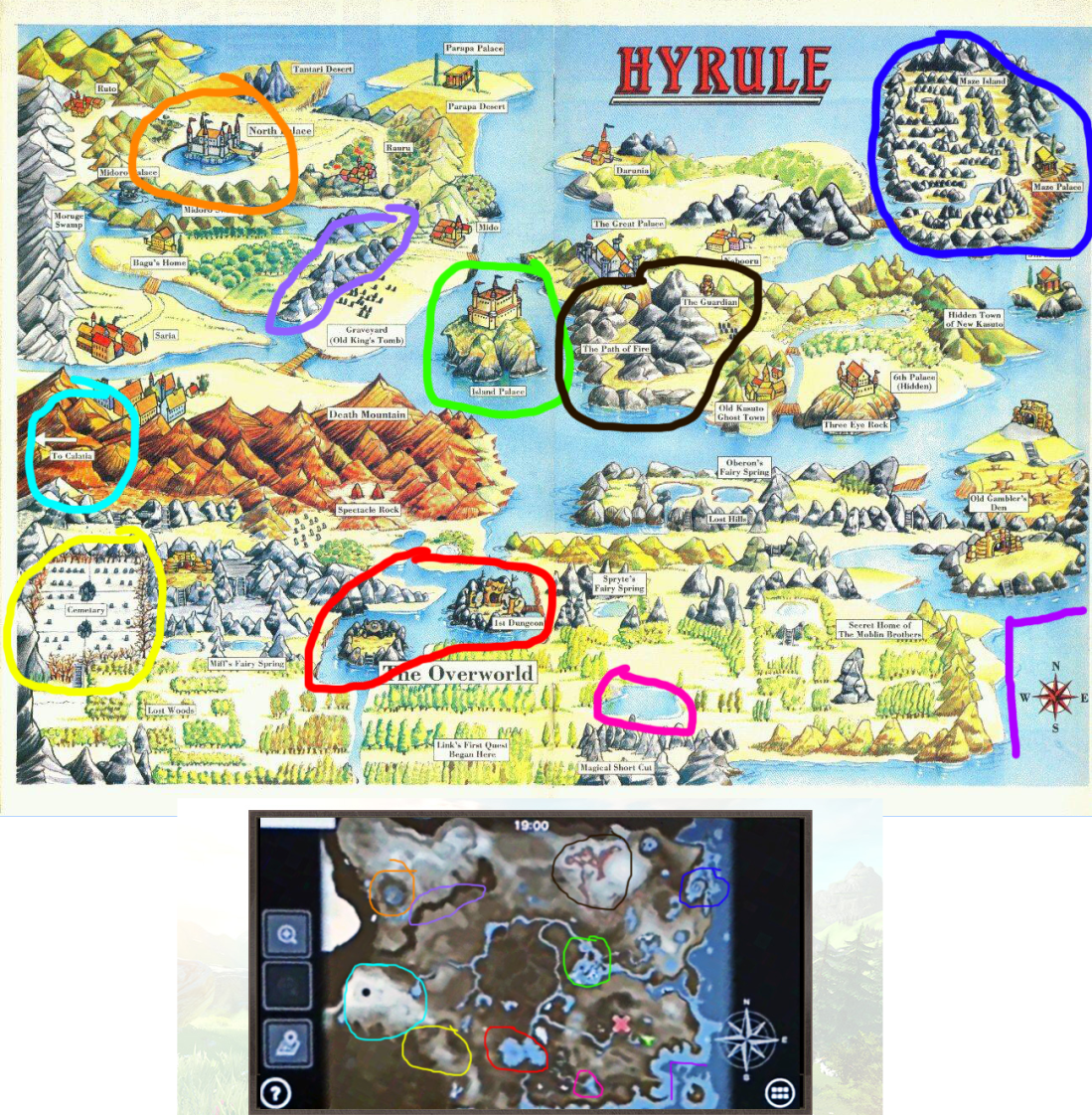 What can also be taken from the map footage is the addition of icons, which will most likely appear as you find new locations; a staple of modern-day open world games. I can only imagine that you will also be able to unlock new icons on the map through dialogue with certain NPCs. The abundance of water in the form of lakes, rivers, and ocean also increases the likelihood of some form of water travel, possibly a boat or other watercraft of some kind. Lava can be seen in the northeast, which is where one would expect to find Death Mountain in recent Zelda canon. It’s unfortunately impossible to differentiate other environments such as snow and desert, but I fully expect to see both represented in some form.
What can also be taken from the map footage is the addition of icons, which will most likely appear as you find new locations; a staple of modern-day open world games. I can only imagine that you will also be able to unlock new icons on the map through dialogue with certain NPCs. The abundance of water in the form of lakes, rivers, and ocean also increases the likelihood of some form of water travel, possibly a boat or other watercraft of some kind. Lava can be seen in the northeast, which is where one would expect to find Death Mountain in recent Zelda canon. It’s unfortunately impossible to differentiate other environments such as snow and desert, but I fully expect to see both represented in some form.
Weapon upgrades from Skyward Sword appear to be returning in some fashion, as can be gleamed from the two different kinds of swords and two different shields seen across the three pieces of footage. Link is also wearing a different tunic in the most recent footage as compared to the introductory teaser, though this may just have been an artistic change by the Zelda team. It would be great, though, if there were a lot of armor/clothes options to choose from, or even the ability to create your own designs à la Animal Crossing with the GamePad.
Epona is definitely going to be Link’s best friend in this game, considering the amount of ground that the player would rather not traverse solely by foot. As Aonuma has already told us, they have designed her AI so she will purposely avoid trees as she gallops across Hyrule Field. This fact alone seems to imply that horse combat will be more important than ever before, considering the last thing players will want to worry about while fighting off pursing beasts is a tree stopping them dead in their tracks.
Epona also carries a number of storage pouches and a bed roll, which may be a sign that she is not only your travel partner, but your inventory box and save point as well. In the first teaser you can see Link’s sword and shield tied to Epona as he leaps into the air, so that may also hint that Link will no longer be able to carry all of his items in his bottomless pockets as in past games.
 Finally, let’s wrap things up by speculating about the story.
Finally, let’s wrap things up by speculating about the story.
From the first teaser trailer it’s clear that Link is an experienced fighter, exhibiting both confidence and finesse as he leaps off Epona’s back to fire off his (possibly associated with the timeshift stones in some way) finishing arrow. This puts him on a different level from most past Links, who is usually portrayed as a courageous, yet naive youth. Link is also seen wearing a hood, which may be due to him being on the run, or at the very least is trying to hide his identity from prying eyes.
As to why this is the case, knowing exactly where the game lies in our beloved Zelda timeline is key. For that answer, Aonuma may have given it to us himself.
While making the latest title for The Legend of Zelda, when I look at [Twilight Princess HD], I feel like this is the origin point of the new title we’re making right now. After playing this game you may have some “Oh I see!” moments when playing the [upcoming] new game, so I’ll be glad if you play Twilight Princess HD while waiting in anticipation for the latest title of Legend of Zelda.
This, tied along with the fact that the Wolf Link amiibo will play some unknown role in the game, seems to hint that the game takes place around Twilight Princess.
However, this is not the only evidence that the Majora’s Mask/Twilight Princess timeline is where the new game will fall. As noted before, the Sheikah also appear to be playing a significant role in the game, and if will delve deeper, we can find a surprising number of connections between Twilight Princess, Majora’s Mask, and the Sheikah.
First let’s look at Twilight Princess. The Fused Shadows, which Link and Midna seek in the first third of the game, come together to create the powerful mask that was created by the so-called Dark Interlopers who sought entry to the Sacred Realm to claim the Triforce. These dark magicians were defeated in the Interloper War before being banished to the Twilight Realm.
Meanwhile, Majora’s Mask was created by an unnamed “Ancient Tribe” for their dark magic rituals before somehow falling into the hands of the Happy Mask Salesman.
Similarities in design between Majora’s Mask and the Fused Shadows has been discussed ever since Midna’s design was first revealed, which raises the question of whether the Dark Interlopers (which are actually only described as a “Hylian tribe skilled in magic” in the Japanese version of Twilight Princess) and Ancient Tribe are one in the same.
If we look even deeper, one can find a design eerily similar to the Sheikah eye on the back of the Fused Shadows mask as well as on the throne in the Twili Realm. Could it be that the creators of the Fused Shadows and Majora’s Mask were the Sheikah, or at least a small group of them that defected?
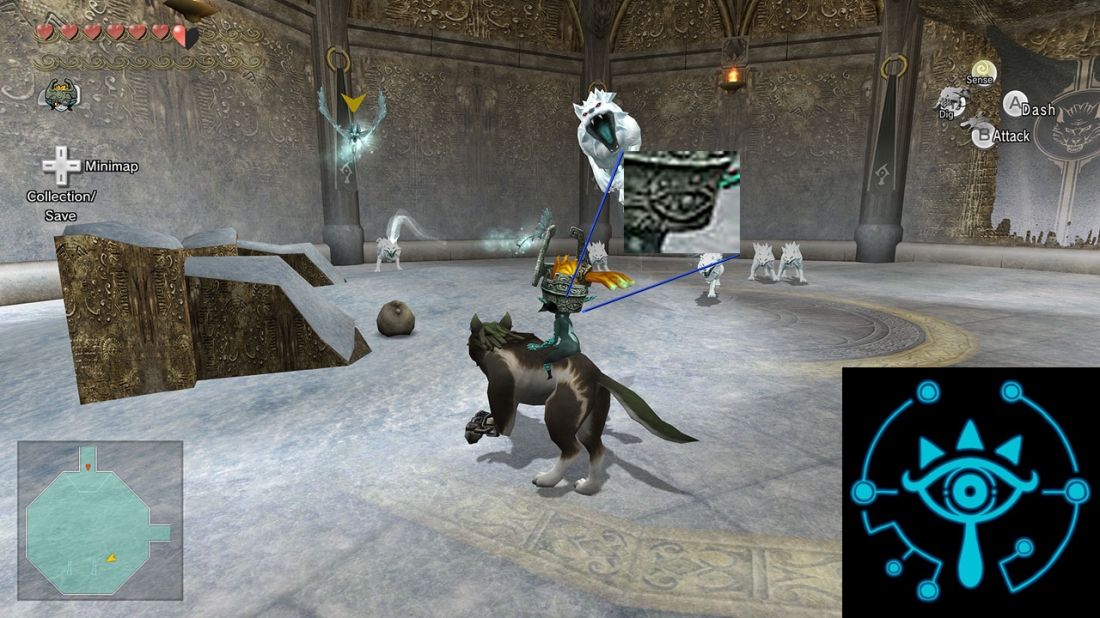 (Getting even crazier, the Happy Mask Salesman himself may be an Interloper/Sheikah, as not only does he know the magical Song of Healing, but also held both Majora’s Mask and the Mask of Truth in his possession. Wouldn’t that be something, to see him again?)
(Getting even crazier, the Happy Mask Salesman himself may be an Interloper/Sheikah, as not only does he know the magical Song of Healing, but also held both Majora’s Mask and the Mask of Truth in his possession. Wouldn’t that be something, to see him again?)
Despite the number of Zelda titles that the Sheikah and their magical artifacts have been present in, we know surprisingly little about the enigmatic tribe. If the Sheikah and the Dark Interlopers are one in the same, and Zelda U takes place during the Interloper War, Link may be wearing a hood in order to hide his identity from the Interlopers trying to find him. Or perhaps Link himself is a Sheikah in this title, and he wears the hood to hide his identity from everyone, since it is likely that all Sheikah would be unjustly persecuted due to the acts of the Interlopers.
In the end, speculation is speculation, and while we won’t get all the answers at E3, we will have a better idea of what to expect while anticipating the game’s launch in 2017. Hope you enjoyed my rambling, and hopefully you are all as excited as I am for the 14th!
LESS THAN 48 HOURS REMAIN

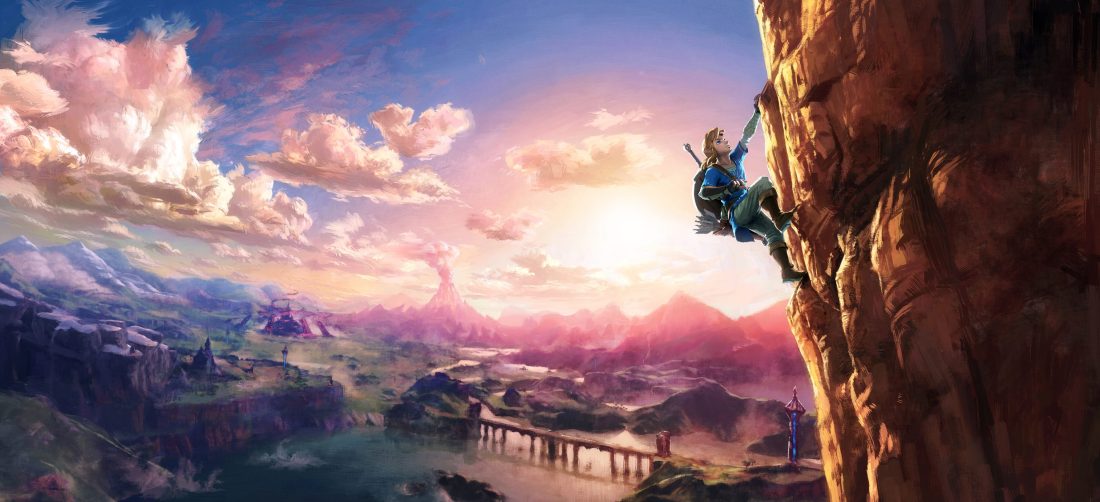
Really can’t wait to see this! Plus I’m thinking it’s a Twilight Princess sequel now…
LikeLike
Part of me wants to avoid all coverage to keep it fresh when I play it but I gotta see if my dreamsa re coming true!
LikeLike
Bill confirmed to be some sort of fortune teller.
LikeLike
The Princess Mononoke references remind me of the speculation around Twilight Princess. The early trailers showed both Link transforming into a wolf and Link holding a hawk, which the internet picked up on as being similar to the film Ladyhawke (film spoliers: the premise of Ladyhawke is a couple are cursed – the man is a wolf by night, the woman a hawk by day). There was also a manga called Twilight Princess with a similar plot to Ladyhawke which added to the speculation.
LikeLike